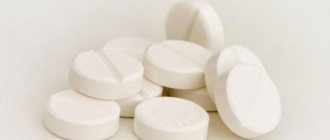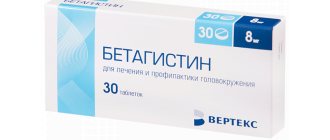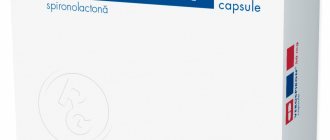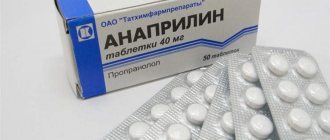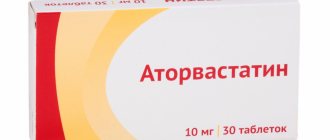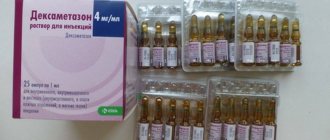Composition and release form
| Injection | 1 amp. |
| sulodexide | 600 LE |
| excipients: sodium chloride - 18 mg; water for preparing injections - qs up to 2 ml |
in ampoules of 2 ml; There are 10 ampoules in a box.
| Capsules | 1 caps. |
| sulodexide | 250 LE |
| excipients: sodium lauryl sulfate - 3.3 mg; silicon dioxide colloid - 3.0 mg; triglycerides - 86.1 mg | |
| capsule composition: gelatin - 55.0 mg; glycerin - 21.0 mg; sodium ethyl p-hydroxybenzoate - 0.24 mg; sodium propyl paraoxybenzoate - 0.12 mg; titanium dioxide (E171) - 0.30 mg; red iron oxide - 0.90 mg |
25 pcs in blister; There are 2 blisters in a box.
Compound
The soft capsule in a gelatin shell contains 250 LE of the active substance sulodexide .
Additional components are: silicon dioxide (colloidal form), sodium lauryl sarcosinate, triglycerides.
The shell consists of titanium dioxide, gelatin, red iron oxide, sodium propyl parahydroxybenzoate, sodium ethyl parahydroxybenzoate and glycerol .
1 ampoule with a clear solution contains 600 LE of the active ingredient sulodexide. The auxiliary components are water and sodium chloride.
Pharmacodynamics
The fast-flowing heparin-like fraction has an affinity for antithrombin III, and the dermatan fraction has an affinity for heparin cofactor II. The anticoagulant effect is due to the affinity for heparin cofactor II, which inactivates thrombin.
The mechanism of antithrombotic action is associated with the suppression of activated factor X, with increased synthesis and secretion of prostacyclin (PGI2), with a decrease in the level of fibrinogen in the blood plasma, etc.
The profibrinolytic effect is due to an increase in the blood level of tissue plasminogen activator and a decrease in the content of its inhibitor.
The angioprotective effect is associated with the restoration of the structural and functional integrity of vascular endothelial cells, with the restoration of the normal density of the negative electrical charge of the pores of the vascular basement membrane. In addition, the drug normalizes the rheological properties of the blood by reducing the level of triglycerides (stimulates the lipolytic enzyme - lipoprotein lipase, which hydrolyzes triglycerides that are part of LDL).
Reduces blood viscosity, inhibits the proliferation of mesangial cells, and reduces the thickness of the basement membrane.
pharmachologic effect
Direct anticoagulant. The active ingredient is the natural component Sulodexide, isolated and extracted from the mucous membrane of the small intestine of pigs.
The active component consists of two glycosaminoglycans: dermatan sulfate and heparin-like fraction.
The drug has the following effects:
- angioprotective;
- anticoagulant;
- profibrinolytic;
- antithrombotic.
The anticoagulant effect is manifested due to the affinity of heparin for cofactor-2, under the influence of which the blood clot is inactivated.
The antithrombotic effect is ensured by an increase in the secretion and synthesis of prostacyclin, suppression of the active X factor, and a decrease in fibrinogen in the blood.
The profibrinolytic effect is achieved by reducing the level of tissue plasminogen activator inhibitor and increasing the level of the activator itself in the blood.
The angioprotective effect is associated with the restoration of adequate density of the minus electric charge of the pores in the vascular basement membranes. Additionally, the effect is ensured by restoring the integrity of vascular endothelial cells (functional and structural integrity).
Wessel Due F reduces triglyceride , normalizing blood rheological parameters. The active component is able to stimulate lipoprotease (a specific lipolytic enzyme), which hydrolyzes triglycerides, which are part of the “bad” cholesterol .
In diabetic nephropathy, the active substance Sulodexide reduces the production of extracellular matrix by suppressing the proliferation of mesangium cells; reduces the thickness of the basement membrane.
Pharmacokinetics
90% is absorbed in the vascular endothelium (creating a concentration in it that is 20–30 times higher than its concentration in the tissues of other organs) and is absorbed in the small intestine. Metabolized in the liver and kidneys. Unlike unfractionated heparin and low molecular weight heparins, sulodexide is not subject to desulfation, which leads to a decrease in antithrombotic activity and significantly accelerates elimination from the body. Dose distribution across organs showed that the drug undergoes extracellular diffusion in the liver and kidneys 4 hours after administration.
24 hours after intravenous administration, urinary excretion is 50% of the drug, and after 48 hours - 67%.
Wessel Due F solution d/inf. 600LE 2ml N 10
Description of the dosage form
Solution for injection: light yellow or yellow transparent solution placed in dark transparent glass ampoules.
Capsules: oval-shaped soft gelatin capsules, brick red in color.
Pharmacodynamics
The fast-flowing heparin-like fraction has an affinity for antithrombin III, and the dermatan fraction has an affinity for heparin cofactor II. The anticoagulant effect is due to the affinity for heparin cofactor II, which inactivates thrombin.
The mechanism of antithrombotic action is associated with the suppression of activated factor X, with increased synthesis and secretion of prostacyclin (PGI2), with a decrease in the level of fibrinogen in the blood plasma, etc.
The profibrinolytic effect is due to an increase in the blood level of tissue plasminogen activator and a decrease in the content of its inhibitor.
The angioprotective effect is associated with the restoration of the structural and functional integrity of vascular endothelial cells, with the restoration of the normal density of the negative electrical charge of the pores of the vascular basement membrane. In addition, the drug normalizes the rheological properties of the blood by reducing the level of triglycerides (stimulates the lipolytic enzyme - lipoprotein lipase, which hydrolyzes triglycerides that are part of LDL).
Reduces blood viscosity, inhibits the proliferation of mesangial cells, and reduces the thickness of the basement membrane.
Pharmacokinetics
90% is absorbed in the vascular endothelium (creating a concentration in it that is 20–30 times higher than its concentration in the tissues of other organs) and is absorbed in the small intestine. Metabolized in the liver and kidneys. Unlike unfractionated heparin and low molecular weight heparins, sulodexide is not subject to desulfation, which leads to a decrease in antithrombotic activity and significantly accelerates elimination from the body. Dose distribution across organs showed that the drug undergoes extracellular diffusion in the liver and kidneys 4 hours after administration.
24 hours after intravenous administration, urinary excretion is 50% of the drug, and after 48 hours - 67%.
Wessel Due F: Indications
angiopathy with an increased risk of thrombosis, incl. after myocardial infarction;
cerebrovascular accidents, including the acute period of ischemic stroke and the period of early recovery;
discirculatory encephalopathy caused by atherosclerosis, diabetes mellitus, hypertension;
vascular dementia;
occlusive lesions of peripheral arteries of atherosclerotic and diabetic origin;
phlebopathy, deep vein thrombosis;
microangiopathy (nephropathy, retinopathy, neuropathy) and macroangiopathy (diabetic foot syndrome, encephalopathy, cardiopathy) in diabetes mellitus;
thrombophilic conditions, antiphospholipid syndrome (together with acetylsalicylic acid, as well as following low molecular weight heparins);
Treatment of heparin-induced thrombotic thrombocytopenia (HTT), since the drug does not cause or worsen HTT.
Wessel Due F: Contraindications
hypersensitivity;
hemorrhagic diathesis and diseases accompanied by decreased blood clotting;
pregnancy (first trimester).
Use during pregnancy and breastfeeding
During pregnancy, it is prescribed under the strict supervision of a doctor. There is positive experience of use for the treatment and prevention of vascular complications in patients with type 1 diabetes in the II and III trimesters of pregnancy, with the development of late toxicosis of pregnancy - gestosis.
Directions for use and doses
IM, IV (in 150–200 ml of saline), orally. At the beginning of treatment, the contents of 1 ampoule are administered intramuscularly daily for 15–20 days, then 1 caps. 2 times a day orally between meals for 30–40 days. The full course should be repeated at least 2 times a year. At the discretion of the doctor, the dosage regimen may be changed.
Wessel Due F: Side effects
From the gastrointestinal tract: nausea, vomiting, epigastric pain.
Allergic reactions: rash.
Other: pain, burning, hematoma at the injection site.
Overdose
Symptoms: Bleeding or bleeding.
Treatment: drug withdrawal, symptomatic therapy.
Interaction
Simultaneous use with drugs that affect the hemostatic system (direct and indirect anticoagulants, antiplatelet agents) is not recommended.
special instructions
If necessary, it is recommended to use the drug under the control of a coagulogram. At the beginning and end of treatment, it is advisable to determine the following indicators: aPTT (normally - 30–40 s, depending on the type and concentration of the activator used, it can be 25–30 or 35–50 s), antithrombin III content (normally - 210–300 mg/l), bleeding time (normal according to Duques - 2-4 minutes), clotting time of unstabilized blood (normal according to the Milian method as modified by Morawitz - 6-8 minutes). Wessel Due F increases normal values by approximately one and a half times.
Characteristic
A natural product isolated from the mucous membrane of the small intestine of pigs. It is a natural mixture of glycosaminoglycans: heparin-like fraction with a molecular weight of 8,000 daltons (80%) and dermatan sulfate (20%).
Indications for the drug Wessel Due F
angiopathy with an increased risk of thrombosis, incl. after myocardial infarction;
cerebrovascular accidents, including the acute period of ischemic stroke and the period of early recovery;
discirculatory encephalopathy caused by atherosclerosis, diabetes mellitus, hypertension;
vascular dementia;
occlusive lesions of peripheral arteries of atherosclerotic and diabetic origin;
phlebopathy, deep vein thrombosis;
microangiopathy (nephropathy, retinopathy, neuropathy) and macroangiopathy (diabetic foot syndrome, encephalopathy, cardiopathy) in diabetes mellitus;
thrombophilic conditions, antiphospholipid syndrome (together with acetylsalicylic acid, as well as following low molecular weight heparins);
Treatment of heparin-induced thrombotic thrombocytopenia (HTT), since the drug does not cause or worsen HTT.
Composition and release form
Active substance: sulodexide 250LE
Excipients: sodium lauryl sulfate - 3.3 mg; silicon dioxide colloid - 3.0 mg; triglycerides - 86.1 mg
Capsule composition: gelatin - 55.0 mg; glycerin - 21.0 mg; sodium ethyl p-hydroxybenzoate - 0.24 mg; sodium propyl paraoxybenzoate - 0.12 mg; titanium dioxide (E171) - 0.30 mg; red iron oxide - 0.90 mg
25 pcs in blister; There are 2 blisters in a box.
Description of the dosage form
Solution for injection: light yellow or yellow transparent solution placed in dark transparent glass ampoules.
Capsules: oval-shaped soft gelatin capsules, brick red in color.
Characteristic
A natural product isolated from the mucous membrane of the small intestine of pigs. It is a natural mixture of glycosaminoglycans: heparin-like fraction with a molecular weight of 8,000 daltons (80%) and dermatan sulfate (20%).
pharmachologic effect
Pharmacological action - profibrinolytic, antithrombotic, anticoagulant, angioprotective.
Pharmacodynamics
The fast-flowing heparin-like fraction has an affinity for antithrombin III, and the dermatan fraction has an affinity for heparin cofactor II. The anticoagulant effect is due to the affinity for heparin cofactor II, which inactivates thrombin.
The mechanism of antithrombotic action is associated with the suppression of activated factor X, with increased synthesis and secretion of prostacyclin (PGI2), with a decrease in the level of fibrinogen in the blood plasma, etc.
The profibrinolytic effect is due to an increase in the blood level of tissue plasminogen activator and a decrease in the content of its inhibitor.
The angioprotective effect is associated with the restoration of the structural and functional integrity of vascular endothelial cells, with the restoration of the normal density of the negative electrical charge of the pores of the vascular basement membrane. In addition, the drug normalizes the rheological properties of the blood by reducing the level of triglycerides (stimulates the lipolytic enzyme - lipoprotein lipase, which hydrolyzes triglycerides that are part of LDL).
Reduces blood viscosity, inhibits the proliferation of mesangial cells, and reduces the thickness of the basement membrane.
Pharmacokinetics
90% is absorbed in the vascular endothelium (creating a concentration in it that is 20–30 times higher than its concentration in the tissues of other organs) and is absorbed in the small intestine. Metabolized in the liver and kidneys. Unlike unfractionated heparin and low molecular weight heparins, sulodexide is not subject to desulfation, which leads to a decrease in antithrombotic activity and significantly accelerates elimination from the body. Dose distribution across organs showed that the drug undergoes extracellular diffusion in the liver and kidneys 4 hours after administration.
24 hours after intravenous administration, urinary excretion is 50% of the drug, and after 48 hours - 67%.
Indications for the drug Wessel Due F
angiopathy with an increased risk of thrombosis, incl. after myocardial infarction;
cerebrovascular accidents, including the acute period of ischemic stroke and the period of early recovery;
discirculatory encephalopathy caused by atherosclerosis, diabetes mellitus, hypertension;
vascular dementia;
occlusive lesions of peripheral arteries of atherosclerotic and diabetic origin;
phlebopathy, deep vein thrombosis;
microangiopathy (nephropathy, retinopathy, neuropathy) and macroangiopathy (diabetic foot syndrome, encephalopathy, cardiopathy) in diabetes mellitus;
thrombophilic conditions, antiphospholipid syndrome (together with acetylsalicylic acid, as well as following low molecular weight heparins);
Treatment of heparin-induced thrombotic thrombocytopenia (HTT), since the drug does not cause or worsen HTT.
Contraindications
hypersensitivity;
hemorrhagic diathesis and diseases accompanied by decreased blood clotting;
pregnancy (first trimester).
Use during pregnancy and breastfeeding
During pregnancy, it is prescribed under the strict supervision of a doctor. There is positive experience of use for the treatment and prevention of vascular complications in patients with type 1 diabetes in the II and III trimesters of pregnancy, with the development of late toxicosis of pregnancy - gestosis.
Side effects
From the gastrointestinal tract: nausea, vomiting, epigastric pain.
Allergic reactions: rash.
Other: pain, burning, hematoma at the injection site.
Interaction
Simultaneous use with drugs that affect the hemostatic system (direct and indirect anticoagulants, antiplatelet agents) is not recommended.
Directions for use and doses
IM, IV (in 150–200 ml of saline), orally. At the beginning of treatment, administer the contents of 1 ampoule daily intramuscularly for 15–20 days, then 1 caps. 2 times a day orally between meals for 30–40 days. The full course should be repeated at least 2 times a year. At the discretion of the doctor, the dosage regimen may be changed.
Overdose
Symptoms: Bleeding or bleeding.
Treatment: drug withdrawal, symptomatic therapy.
special instructions
If necessary, it is recommended to use the drug under the control of a coagulogram. At the beginning and end of treatment, it is advisable to determine the following indicators: aPTT (normally - 30–40 s, depending on the type and concentration of the activator used, it can be 25–30 or 35–50 s), antithrombin III content (normally - 210–300 mg/l), bleeding time (normal according to Duques - 2-4 minutes), clotting time of unstabilized blood (normal according to the Milian method as modified by Morawitz - 6-8 minutes). Wessel Due F increases normal values by approximately one and a half times.
A comment
Wessel Due F, capsules - packaging Pharmakor Production (Russia).
Wessel Due F, ampoules - packaging Pharmakor Production (Russia).
Storage conditions for the drug Wessel Due F
- At a temperature not exceeding 30 °C.
- Keep out of the reach of children.
Shelf life of the drug Wessel Due F
- 5 years.
- Do not use after the expiration date stated on the package.
special instructions
If necessary, it is recommended to use the drug under the control of a coagulogram. At the beginning and end of treatment, it is advisable to determine the following indicators: aPTT (normally - 30–40 s, depending on the type and concentration of the activator used, it can be 25–30 or 35–50 s), antithrombin III content (normally - 210–300 mg/l), bleeding time (normal according to Duques - 2-4 minutes), clotting time of unstabilized blood (normal according to the Milian method as modified by Morawitz - 6-8 minutes). Wessel Due F increases normal values by approximately one and a half times.
Vesel Due, instructions for use (Method and dosage)
In the first 15-20 days, the medication is administered parenterally. Intravenous and intramuscular injections are allowed. Intravenous administration can be drip or bolus.
Scheme: 2 ml (600 LE - 1 ml) of the contents of the ampoule are dissolved in a physiological solution with a volume of 200 ml. Upon completion of injection therapy, they switch to taking the drug in capsule form for 30-40 days. Twice a day, 1 capsule. The preferred time is between meals.
It is recommended to take 2 courses annually. The instructions for Vesel Due F contain an indication of the possibility of changing the above-described treatment regimen, taking into account individual characteristics, tolerance, and other concomitant diseases.

